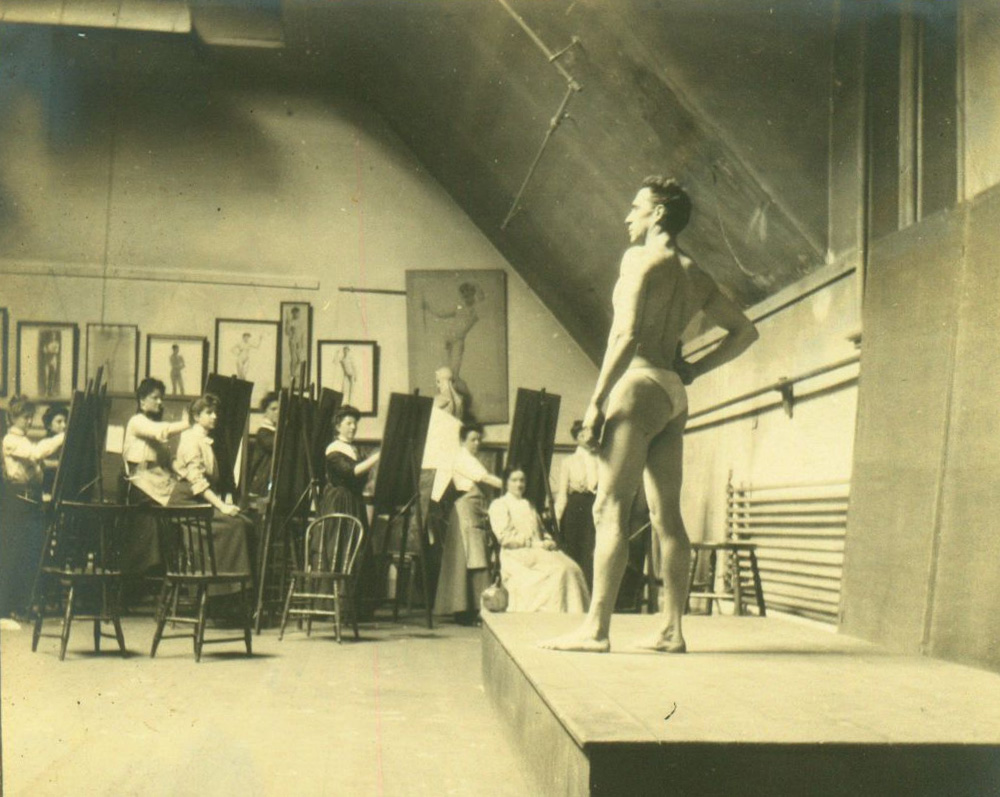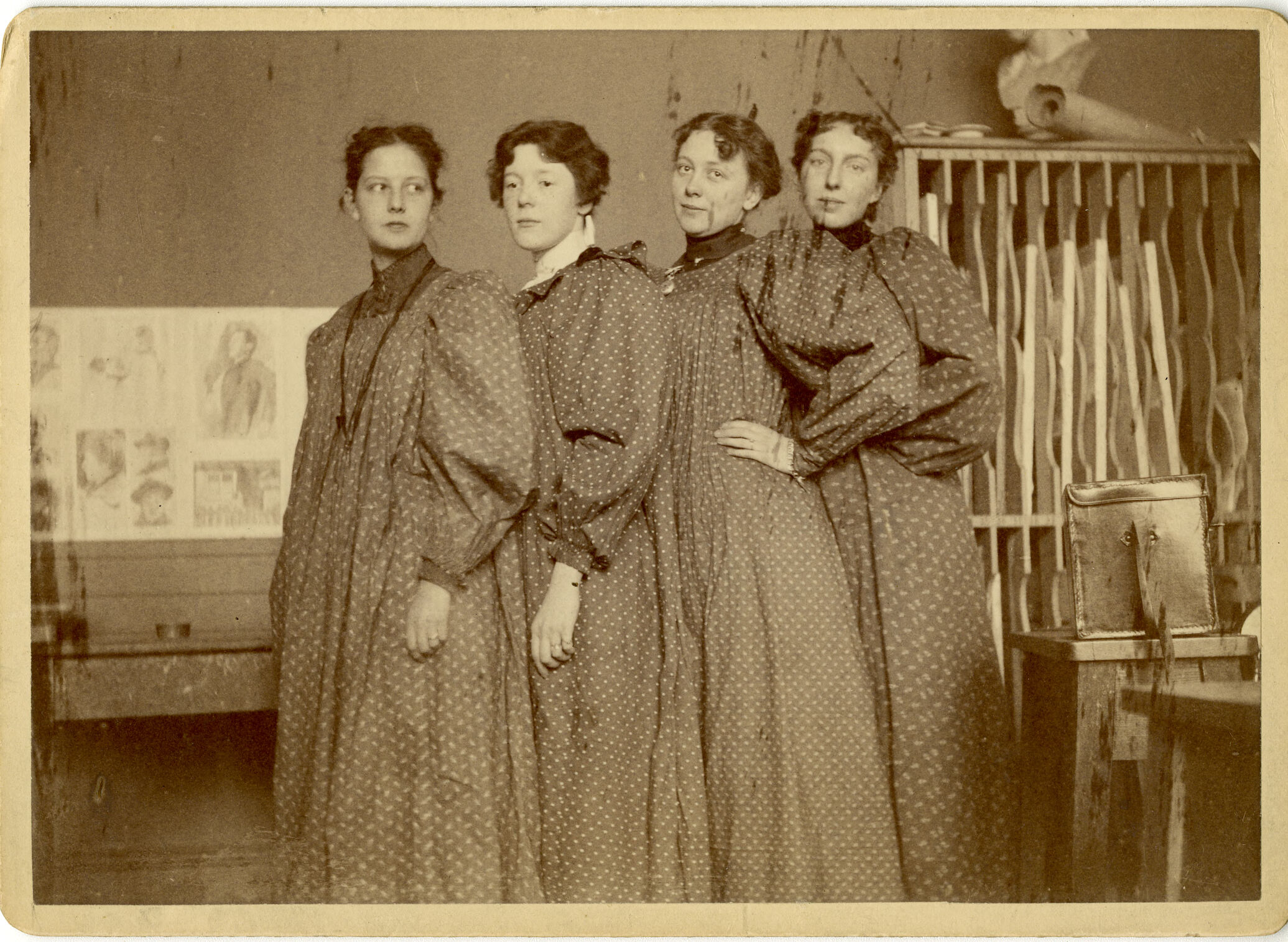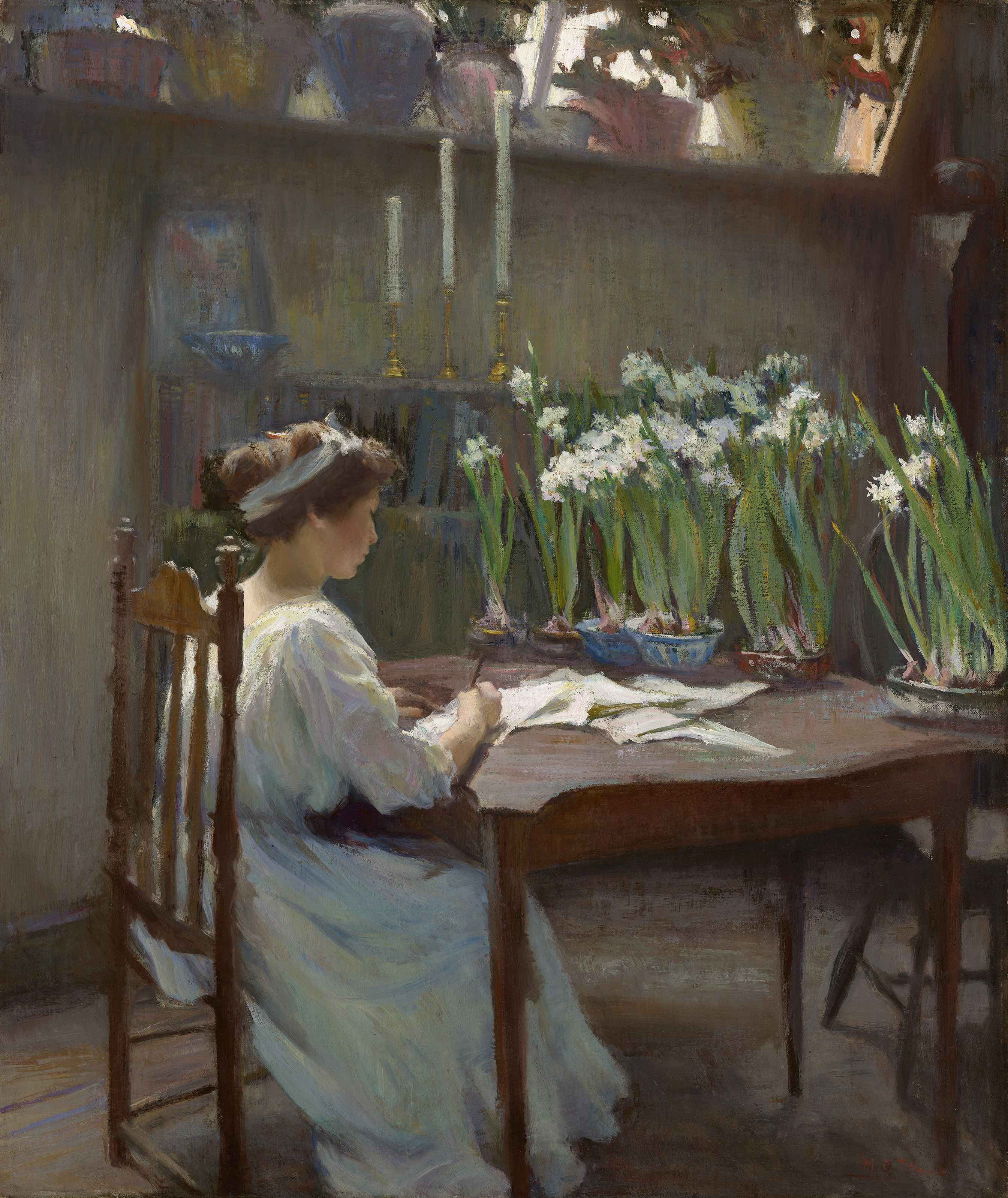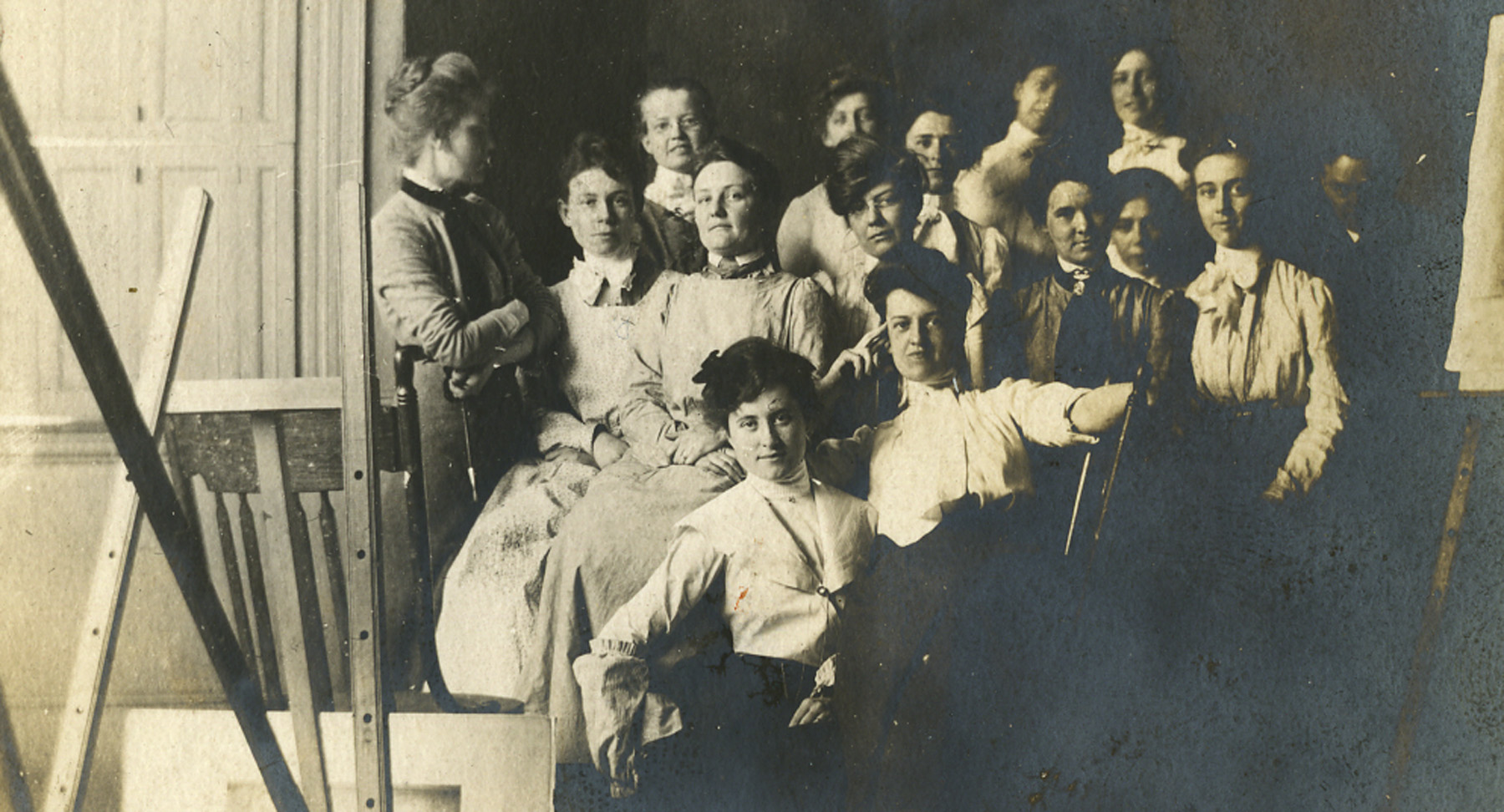“I do not want anything I have done put forward on the basis of its being the work of a woman.”
Prolific Boston sculptor Anne Whitney said these bold words in 1892. She and a generation of women had worked hard to have the same opportunities as their male counterparts. They refused to be valued as only women artists. Through advocacy and grit, they had secured a spot at the table.
But then something happened. As time passed, the contributions of these leading artists were forgotten. The early 20th-century movement known as the Boston School came to be represented by male painters and the women that played a central role in the group were largely forgotten.
We recently added three paintings to our collection: Five O’Clock by Gretchen W. Rogers, The Breakfast Tray by Elizabeth Okie Paxton, and The Writer by Mary Bradish Titcomb. Through these works, we can better understand the women of the Boston School and tell their story. As Nancy Anderson, curator and head of our department of American and British paintings says, “Now we can show that they were every bit as accomplished as their male contemporaries.”
The Beginnings of the Boston School
Boston School painters “were united by the intense belief that the primary goal of art was to create beauty,” explains Erica E. Hirshler, a senior curator at the Museum of Fine Arts, Boston.
Bostonians were among the first Americans to appreciate and collect paintings by impressionists like Claude Monet. Boston School painters were inspired by the French impressionists’ use of color and light effects in landscapes. They were also fascinated with Dutch painter Johannes Vermeer. Boston School painters were drawn to the artist’s technical skill and unparalleled rendering of light. And they could study his work in person—when it opened in 1903, the Isabella Stewart Gardner Museum displayed Vermeer’s The Concert.

Edmund Tarbell, Josephine and Mercie, 1908, oil on canvas, Corcoran Collection (Museum Purchase, Gallery Fund), 2014.136.8

William McGregor Paxton, The House Maid, 1910, oil on canvas, Corcoran Collection (Museum Purchase, Gallery Fund), 2014.136.11
The Boston School blended the impressionist palette and texture with Vermeer’s interior domestic scenes. Today paintings like Josephine and Mercie by Edmund Tarbell and The House Maid by William McGregor Paxton (Elizabeth Okie Paxton’s husband) may seem traditional. But the style felt new in the early 20th century.
The serene scenes primarily featured women. Some have said that they reinforce Victorian ideas of women’s role in society. But Anderson notes that “these images were created at a time when feminism was beginning to boil.” Artists like Tarbell and Paxton were well aware of women’s evolving place in society. After all, they were working side-by-side with women artists.
An artistic education for women is finally possible
In the middle of the 19th century, Boston art schools began to open their doors to women. Women jumped at the chance to become artists. “It is only when schools start opening up that women start to be able to even conceive of an equal playing field,” notes Hirshler.
Between 1850 and 1882, a slew of art schools opened in Boston. These included the Massachusetts Normal Art School (now the Massachusetts College of Art and Design) and the School of Drawing and Painting at the Museum of Fine Arts (which later became the School of the Museum of Fine Arts or SMFA). Women filled the classrooms. At the Normal Art School, 65% of enrolled students were women. By 1889 a newspaper reported that nearly 82% of the SMFA students were women.

Unknown photographer, Woman’s Life Class, 1901-1902. School of the Museum of Fine Arts records. Tufts Archival Research Center. Medford, MA.

A group of students in painting smocks at the Massachusetts Normal Art School in 1898, MassArt Archives
Women still struggled to get a full education. “It was thought completely inappropriate for a woman to draw from a male model,” Hirshler explains. Some suggested that women students wear veils during lessons. Art students began by drawing from plaster casts of classical sculptures before moving to human models. But, Hirshler adds, “even statuary galleries were sometimes restricted.”
Without the proper foundation, women would be limited to still life paintings. Some women found ways around the restrictions by enrolling in private classes with prominent teachers like William Morris Hunt. Eventually, most got over the scandal. One student, Elizabeth Bartol, described the ability to study the human figure as transformative. “I think many of the women who are now most successful at work must remember with an undying gratitude the impulse of that class.”
Three women of the Boston School
At first glance, Gretchen W. Rogers’s, Mary Bradish Titcomb’s, and Elizabeth Okie Paxton’s works seem familiar. They look to be the same quiet interior scenes as those of their male Boston School counterparts. In some ways, they are. Rogers depicts a woman with a teacup and Titcomb shows a woman writing. Okie Paxton paints a bedroom.
The women of the Boston School made works that appealed to the tastes of contemporary collectors. “They sought to join the establishment, not to overthrow it,” Hirshler writes. “To prove that they were serious painters, most of Boston’s women artists worked within the aesthetic and social conventions of their day.” But closer inspection reveals the feminist messages in these three scenes.

Gretchen W. Rogers, Five O'Clock, c. 1910, oil on canvas, Gift of Funds from James and Christiane Valone in memory of James F. Penrose, 2022.131.1
In Rogers’s Five O’Clock, a woman sits facing away from us. An elaborate hat covered in flowers, fruits, and leaves obscures her eyes. The painting’s title and the teacup the woman holds are significant. Together they refer to a community of elder women that supported younger generations of aspiring “career women.”
Young women came from all over New England to study in Boston, including at the School of the Museum of Fine Arts. In 1899 a committee of women at the SMFA began hosting a daily 5:00 p.m. teatime for students. This group of elder women built community and connection to address the isolation of young women. Rogers’s painting honors this space created by women, for women.

Mary Bradish Titcomb, The Writer, c. 1912, oil on canvas, Gift of Funds from James and Christiane Valone in honor of Nancy K. Anderson, 2023.135.1
The woman in Titcomb’s The Writer is posed similarly in an upright wooden chair. She sits at a table with papers splayed around her. Rows of blooming narcissuses fill the far edge. Light streams in from the window above her. The painting’s title and the mess of papers make it clear that the woman shown isn’t a casual letter writer, but a professional writer.
Titcomb kept this painting in her collection her entire life. The subject of a woman working to establish herself was personal to the painter. After more than a decade as an art teacher (she had attended the Normal Art School) she quit to pursue painting professionally. Titcomb studied at the SMFA with Boston School artists Edmund Tarbell and Frank Weston Benson and joined their circle.
The Writer shows Titcomb’s own space in the Grundmann Studios. Grundmann, and later the Fenway Studios, were the homebase of the Boston School painters. Many women worked in both studios. But they were hard-won spaces. Other female painters of the Boston School—like Okie Paxton and Lilian Westcott Hale—worked from home or gave up their studios altogether when they were married. Paxton only claimed her space at Fenway Studios once her husband William McGregor Paxton passed away.

Elizabeth Okie Paxton, The Breakfast Tray, c. 1910, oil on canvas, Gift of Funds from Mary and Allan Kollar in honor of Nancy K. Anderson, 2023.138.1
Okie Paxton focused most of her paintings on domestic interior scenes and still lifes. Some were published in women’s magazines like House & Garden. While women are shown in Rogers' and Titcomb's paintings, Okie Paxton's The Breakfast Tray centers on the private lives of women without showing an actual woman.
The paintining shows off her skills at painting objects. The tray is just balanced on the edge of the chair. But compared to her still lifes of kitchen dishes, this painting has racier undertones. The unkempt bed, cascading sheets, and carelessly tossed black heels seem to suggest the aftermath of a bedroom tryst. Without any people in the painting, we are left to imagine the details. The provocative subject was daring for the time.
Reconsidering the Boston School
By the time Whitney made her statement calling for equal consideration, women could train to be artists. They could make a living selling and exhibiting their works. Rogers, Titcomb, and Paxton all exhibited actively in Boston and beyond. All three were even featured at the Corcoran Gallery of Art.
And Boston women had joined the upper ranks of other professions too. They were doctors, authors, newspaper editors, public speakers, designers, and activists. The end of the 19th century seemed promising for women.
But as the 20th century continued and the height of the Boston School passed many of these women artists were forgotten. Men like Tarbell, Benson, and McGregor Paxton dominated histories of the art movement. The Corcoran Gallery acquired the men’s works—but not the paintings of their female counterparts. Museums displayed scenes of light-dappled interiors that included women only as subjects. Works by women artists ended up in storerooms or were treated like wallpaper in private homes.
Finally, more than a century after these glaring omissions, Rogers’s and Titcomb’s paintings are now on view in our American galleries, and Okie Paxton’s will soon join them. “We’re making progress,” Anderson says.
And we are closer to telling the full story of the Boston School.
Banner image: A group of students at the Massachusetts Normal Art School in 1901 (now the Massachusetts College of Art and Design), MassArt Archives
